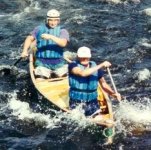I did a couple of trips on Saturday up in NH with a local club. Saturday morning on the Sugar River - 21 boats, 20 kayaks and one canoe (me). Saturday afternoon on Croyden Brook - 9 boats, 8 kayaks and one canoe (me). The sad thing is it is not unusual for me to be the only open boat in a group of kayakers. The kayakers seem fine with it, and I am pretty careful about what I run - I don't want to be the guy who swims all the time. Don't get me wrong, there is a small but dedicated group of solo open boaters around - lot of them are slalom racers, a lot paddling Millbrook boats, and a lot are better paddlers than me. It's a real treat when I get out with them, but schedules don't always align.
I guess we all know what happened to the solo whitewater canoes - they retired and got replaced by kayakers. Its a shame. The best way to learn whitewater paddling is in a solo boat where you have to be your own bow and stern paddler. I love paddling tandem with a good solo paddler. My favorite whitewater trip hands-down was a tandem run on the Dead with my friend Jonathan in his Explorer. (We portaged Upper and Lower Poplar, but that is a story for another time.)
So what do you think - how did you get into whitewater paddling, and what whitewater are you paddling now.
.
I guess we all know what happened to the solo whitewater canoes - they retired and got replaced by kayakers. Its a shame. The best way to learn whitewater paddling is in a solo boat where you have to be your own bow and stern paddler. I love paddling tandem with a good solo paddler. My favorite whitewater trip hands-down was a tandem run on the Dead with my friend Jonathan in his Explorer. (We portaged Upper and Lower Poplar, but that is a story for another time.)
So what do you think - how did you get into whitewater paddling, and what whitewater are you paddling now.
.


